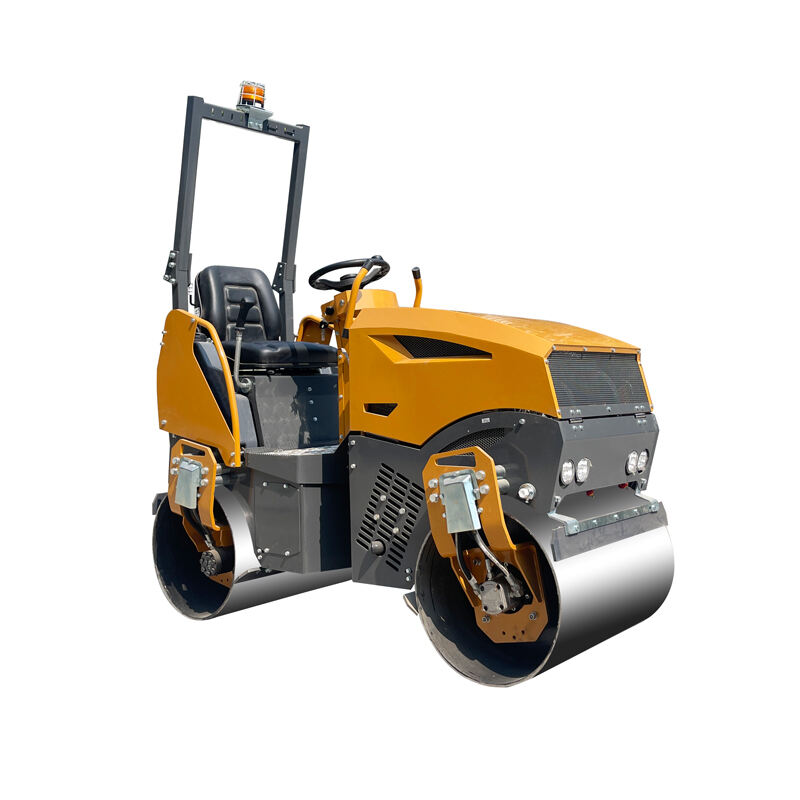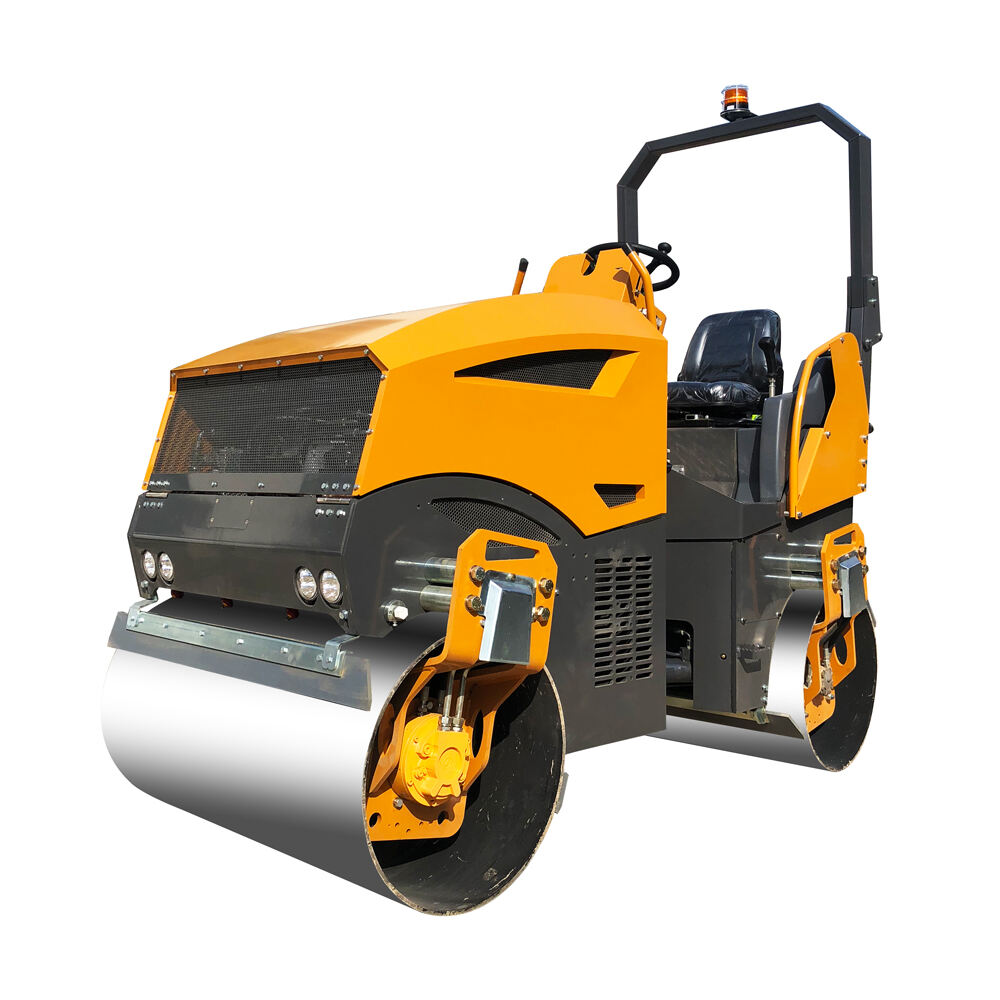Choosing the Right Road Roller for Your Project
Understanding Road Roller Types and Applications
Vibratory Rollers vs. Static Rollers
In road building work, vibratory and static rollers each have their own place on the job site. Vibratory models typically run off hydrostatic motors that create those telltale shaking motions which pack down material much deeper than regular rolling would allow. Road crews find these particularly useful when laying asphalt or working with loose aggregates like gravel and sand because they really lock down the surface layer. Static rollers take a different approach altogether though. These machines rely purely on their massive weight to press down whatever needs compacting. They come in handy for things like clayey soils where all that vibrating wouldn't do much good anyway. Studies show that vibratory equipment can get about 20 to 30 percent better results when it comes to packing density compared to the old school static type. That kind of difference matters a lot when contractors are trying to meet spec requirements for new highways or major infrastructure upgrades.
Learn more about Vibratory Roller.
Asphalt Rollers for Surface Compaction
Rollers made of asphalt play a really important role during road building when it comes to compacting surfaces so roads end up smooth and last longer. When these machines roll over the asphalt they spread out even pressure throughout different layers which makes the road denser and tougher against wear and tear. Research indicates that proper rolling can boost surface density somewhere around 20-25 percent, which means roads stay stable under traffic for much longer periods. There are several types available on the market today like tandem models with two drums side by side, pneumatic ones filled with air bags that adjust pressure automatically, plus combinations of both styles. Tandem rollers get great results because of those twin drums working together while pneumatic versions handle sensitive layers better since operators can tweak how hard they press down depending on what material they're dealing with at any given moment.
Discover more about Asphalt Roller.
Choosing Between Single-Drum and Tandem Rollers
Choosing between different types of rollers really comes down to what kind of job needs doing. For big patches of loose dirt and gravel, single drum rollers get the job done fast thanks to that heavy front drum. Construction crews love them for laying foundations, though they won't give those nice smooth finishes needed for final touches. Tandem rollers have drums front and back which makes them great for asphalt work where even pressure matters most. Most contractors will tell anyone who asks that when working with raw earth, nothing beats a good single drum for getting things packed tight quickly. But when paving roads or parking lots, those tandem models become indispensable despite costing more to operate. The trade off is pretty straightforward actually single drums pack harder but struggle in tight spaces, whereas tandems handle almost everything except maybe the toughest terrain conditions.
Find out more about Single Drum Roller.
Key Technical Factors in Road Roller Selection
Operating Weight and Compaction Force
When choosing a road roller, getting the hang of operating weight and compaction force matters a lot. The weight of the machine affects how much force it can apply during compaction, which determines how well different surfaces get packed down. Heavier machines generally pack harder because they push deeper into the ground material. Take a look at numbers: road rollers that weigh around 10-20 tons work great on compacting dense soils, while smaller units handle asphalt jobs and lighter materials better. Field tests over the years have repeatedly shown that there's a clear link between what the roller weighs and how good the final compaction turns out. That's why contractors spend so much time thinking about these specs before making a purchase decision.
Drum Width & Vibration Frequency Impact
When it comes to road rollers, the width of the drum makes a big difference in how compaction forces get spread across surfaces. Bigger drums can handle larger areas at once, which speeds things up during compaction work, though they sometimes miss those tight spots where precision matters most. For jobs needing careful attention to detail, narrower drums tend to do better because they fit into corners and around obstacles more easily. What really gets the job done right is the vibration frequency these machines produce, usually counted in vibrations per minute. This setting determines how well the roller actually interacts with whatever surface it's working on. Most specs recommend certain frequencies based on what material we're dealing with gravel versus soil versus asphalt for instance but experience shows there's no one size fits all solution out there. Understanding both drum sizes and vibration settings helps contractors pick equipment that works best for their particular projects, balancing speed against quality results without breaking budgets.
Hydraulic Systems and Fuel Efficiency
The hydraulics in road rollers play a key role in boosting their overall performance. These systems help operators maintain smooth running conditions by controlling power delivery and speed adjustments, which directly affects how well the roller compacts surfaces and makes day-to-day operations easier for crews. The way these hydraulic systems are set up matters a lot when it comes to fuel burn rates. Some modern setups actually cut down on fuel usage because they spread power more effectively throughout the machine. Contractors who have upgraded their equipment report real savings at the pump, sometimes cutting monthly expenses by thousands. Plus, these efficient systems tend to last longer between repairs. Looking at actual field data from construction sites across the country shows that investing in better hydraulics pays off over time through lower maintenance bills and extended service life of the machines. Making smart choices about hydraulic efficiency isn't just good business sense, it also supports greener practices in road building projects.
Project-Specific Compaction Requirements
Soil Type Analysis for Roller Choice
Knowing what kind of soil we're dealing with makes all the difference when picking out the right road roller for compaction work. The industry uses several classification methods including USCS and AASHTO standards to sort soils by things like particle size and how much they hold water. These properties directly affect how well different rollers will perform. Most professionals recommend running proper soil tests first thing before making any equipment decisions. Sandy soils usually respond best to vibratory rollers while clayey ground needs something with better grip like padfoot models. Taking this careful approach means the chosen roller actually works well with whatever kind of dirt lies beneath the surface at each construction site.
Small-Scale vs. Highway Project Scaling
When it comes to compacting materials, there's quite a gap between what's needed for little jobs versus big roadwork. For things like backyard driveways or neighborhood parking spaces, contractors typically grab smaller rollers that are easier to handle around tight corners and obstacles. But when building highways or major roads, crews need those big beasts - the kinds of machines that can tackle huge stretches of asphalt without breaking a sweat. Bigger projects mean bigger investments too. Someone who's actually managed construction sites knows that picking the wrong sized roller for the job isn't just about getting the work done faster. It directly impacts bottom line numbers. A driveway might get finished quicker with a medium sized machine, while trying to do highway work with something too small would turn into a money pit fast.
Maneuverability in Tight Spaces
Getting around matters a lot when operating road rollers in tight spots or city environments. Machines with adjustable steering, smaller footprints, and responsive controls make all the difference in these tricky situations. Take compact walk behinds or mini ride ons for example they're commonly used on construction sites where space is at a premium. Contractors report finishing jobs faster in narrow alleys and crowded urban areas thanks to better maneuverability. The industry has seen plenty of real world successes from equipment upgrades that let operators squeeze through tight corners without damaging surrounding structures. Zero turn radius features and good braking systems aren't just fancy specs they actually help workers complete tasks safely even in the most challenging job site conditions.
STORIKE Vibratory Rollers: Product Breakdown
ST1300 | 1.3 Ton Compact Roller Features
The ST1300 stands out as a workhorse among vibratory rollers, capable of tackling all sorts of compaction jobs on different surfaces. What makes it special? An articulated double drum setup that spreads pressure evenly throughout the job site, so compaction results stay consistent no matter what kind of material we're dealing with. Weighing just 1.3 tons at operation, this machine isn't going to strain itself on smaller sites where space gets tight. Operators love the 920mm working width paired with those 560mm drums, especially when working on city streets or patching roads in town centers. Under the hood sits a trusty Kubota engine that keeps running strong through tough conditions. Plus, there's that handy stepless speed adjustment system along with controls designed to reduce operator fatigue during long days on site. Contractors who've used the ST1300 often mention how surprisingly nimble it feels despite its size, and many point to reduced project times thanks to better compaction from day one.

ST2000 | 2-Ton Hydraulic Performance
The ST2000 comes equipped with a top notch hydraulic system that delivers serious power across all sorts of road building jobs. With its dual drum vibration setup and solid 2 ton frame, this machine packs quite a punch when it comes to compacting both soil and asphalt layers. What really sets it apart though are those smooth running hydraulics controls which let operators adjust speeds on the fly something that makes all the difference when working on tight specs or tricky spots in the pavement. Contractors love using these machines out in big open sites where saving hours on the clock means everything to their bottom line. From what we've seen in the field, crews consistently report better compaction results thanks to how balanced everything is built around those advanced hydraulics. No wonder so many road crews have made the switch to ST2000 rollers for getting the job done right and faster.

ST3000 | Heavy-Duty 3-Ton Applications
Built tough for serious work, the ST3000 handles those big jobs that need serious compaction power. Weighing in at 3 tons with solid construction throughout, this machine was made for massive infrastructure projects where steady pressure makes all the difference between good results and great ones. The working width measures 1355 mm across, so it gets through lots of ground quickly, cutting down on how long projects take overall. Many experienced contractors swear by this model when building highways or other major roads because it keeps performing even when things get rough on site. What sets the ST3000 apart? It comes equipped with hydraulic steering plus an engine that doesn't guzzle fuel while still packing plenty of punch. These features combine to deliver real world performance that goes beyond what most folks expect from standard heavy duty rollers.

Operational Longevity and Brand Considerations
CE-Certified Build Quality Standards
The CE certification serves as an important indicator of quality when it comes to road rollers, showing compliance with strict European regulations designed to protect worker safety, public health, and the environment. Getting this certification means the machines meet solid quality benchmarks and tend to hold up well under tough conditions on construction sites. Research indicates that road rollers with CE marking typically last longer in operation and break down less frequently, which makes them reliable purchases for contractors. Plus, having CE certification usually boosts what these machines sell for later on, providing real value both now during daily operations and down the line financially for companies working in the construction sector.
Warranty Support and Local Dealer Networks
When buying road rollers, warranty support should definitely be on the radar because it acts like insurance against those surprise breakdowns that happen out of nowhere. Good warranties typically take care of repairs, replacement parts, sometimes even routine maintenance checks so operations don't get held up. Local dealer networks matter just as much though. Having nearby service centers means getting parts faster and fixing problems quicker rather than waiting weeks for shipments. Contractors who've owned these machines for years will tell anyone willing to listen how fast response times from dealers really keep their projects moving forward without budget-busting delays. Put simply, companies looking at new rollers need to seriously weigh both solid warranty coverage and accessible dealer support before making a purchase.
Ergonomic Design for Operator Safety
Ergonomic design matters a lot when it comes to road rollers because it makes a big difference for operator safety and comfort levels. Most modern machines now come with things like seats that can be adjusted, materials that cut down on noise, and control panels that are easier to work with, all of which help reduce how tired operators get during long shifts while actually getting more done. These days, many road rollers have bigger cabins with good airflow, so workers can see what they're doing clearly and stay comfortable even when temperatures swing around. Real world experience shows that when these ergonomic features are properly implemented, operators tend to perform better since they don't get as worn out from constant strain, which means projects run smoother overall. Companies that spend money on equipment with proper ergonomic design aren't just looking after their workers' health they also end up with better productivity numbers and fewer safety incidents at construction sites.
 EN
EN
 AR
AR CS
CS DA
DA NL
NL FI
FI FR
FR DE
DE IT
IT NO
NO KO
KO PL
PL PT
PT RO
RO RU
RU ES
ES SV
SV TL
TL ID
ID LV
LV SR
SR SK
SK SL
SL VI
VI SQ
SQ ET
ET TH
TH TR
TR AF
AF MS
MS GA
GA HY
HY KA
KA BS
BS LA
LA MN
MN MY
MY KK
KK UZ
UZ KY
KY







